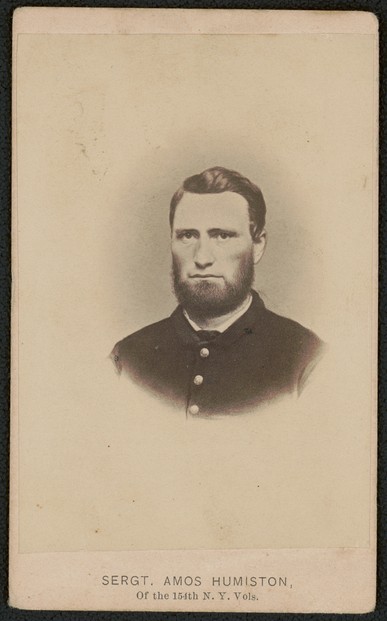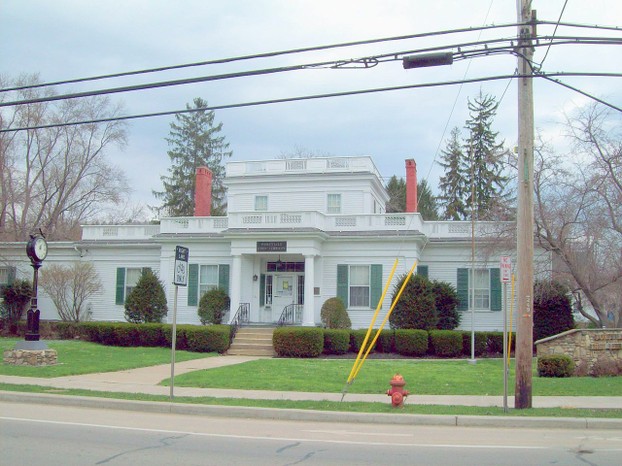Amos Humiston
ca. 1862-1863 albumen print on card mount by Frederick Gutekunst (September 25, 1831-April 27, 1917), Philadelphia, Pennsylvania
Library of Congress, Liljenquist Family Collection of Civil War Photographs: No known restrictions on publication, via Library of Congress Prints & Photographs Online Catalog (PPOC) @ https://www.loc.gov/resource/ppmsca.70271/
Mid-19th century building, placed on National Register of Historic Places in 1991, dates from Amos' years in Portville, New York: its owner Smith Parish, visiting 154th's camp near Virginia Front, carried letters, including Amos', back home.
Built in 1847 for Vermont transplant Smith Parish (October 29, 1804 - July 24, 1887), the Georgian Colonial style two-story three-bay dwelling was expanded with one-story one-bay wing in 1860s and became Portville Free Library in 1909.
Portville Free Library, 2 North Main Street, Portville, Cattaraugus County, southwestern New York: Pubdog, Public Domain, via Wikimedia Commons @ https://commons.wikimedia.org/wiki/File:Portville_Free_Library_Apr_10.JPG
Amos' baptism of fire occurred at Chancellorsville, General Robert E. Lee's perfect battle, marred four days after victory by the death of gifted tactician, Lt. Gen. Thomas Jonathan "Stonewall" Jackson (January 21, 1824 – May 10, 1863).
"Battle of Chancellorsville, May 2, 3 & 4, 1863: Confederate troops under the command of General Stonewall Jackson advancing on the Union army; also shows General Jackson being wounded, with three officers coming to his aid."
1889 chromolithograph by Kurz & Allison, Chicago, Illinois; Library of Congress Prints and Photographs Division: No known restrictions on publication, via Library of Congress Prints & Photographs Online Catalog (PPOC) @ https://www.loc.gov/pictures/item/91482103/
Emmitsburg, Maryland: Amos' last stop before Gettysburg was a paradise of kindness for Confederate and Union troops alike, thanks to the Sisters of Charity.
"Pursuit of Lee's army. Scene on the road near Emmitsburg -- marching through the rain": July 7, 1863 oil painting by Edwin Austin Forbes (1839-March 6, 1895)
Library of Congress Prints and Photographs Division, Morgan Collection of Civil War Drawings: No known restrictions on publication, via Library of Congress Prints & Photographs Online Catalog (PPOC) @ https://www.loc.gov/pictures/item/2004661897/
Frank Leslie's Illustrated Newspaper, January 2, 1864: "An incident of Gettysburg -- the last thought of a dying father" (page 236)
wood engraving print; Library of Congress Prints and Photographs Division: No known restrictions on publication, via Library of Congress Prints & Photographs Online Catalog (PPOC)
@ https://www.loc.gov/pictures/item/2002709419/
"Children of the Battlefield"
albumen photographic print copy of ferrotype, or tintype, portrait, by Wenderoth, Taylor & Brown of Philadelphia, that was found postmortem in Amos Humiston's hands
Library of Congress Prints and Photographs Division, Liljenquist Family Collection of Civil War Photographs: No known restrictions on publication, via Library of Congress Prints & Photographs Online Catalog (PPOC) @ https://www.loc.gov/pictures/item/2012650047/
Amos Humiston's final resting place in Soldiers’ National Cemetery, Gettysburg, Pennsylvania
NY Plot B-14; New York section, near Michigan section, of second, or outer, arc
photo by Officer Candidate Brendan Mackie, Delaware National Guard Public Affairs: Public Domain, via Wikimedia Commons @ https://commons.wikimedia.org/wiki/File:Army_staff_ride_to_Gettysburg_150711-Z-DL064-042.jpg; Public Domain, via DVIDS Defense Visual Information Distribution Service @ https://www.dvidshub.net/image/2059277/army-staff-ride-gettysburg
Gettysburg: a town like no other, with hallowed ground consecrated by the "brave men, living and dead, who struggled here" (Gettysburg Address)
Lincoln Square, downtown Gettysburg; north of Gettysburg National Cemetery; Wednesday, March 20, 2013: Tom Hart (thart2009), CC BY 2.0, via Flickr @ https://www.flickr.com/photos/thart2009/8581444574/
Orphans' Homestead, dedicated November 20, 1866, located near Amos' grave, was home for Amos' widow and three children until family relocated in 1871 to Becket, Massachusetts, after Philinda's marriage in 1869 to third husband, Asa Barnes.
Photo: Gen. S.W. Crawford, Gen. A. Porter, Gov. John Geary, and Gen. U.S. Grant outside orphanage during Gen. Grant's visit to Gettysburg on June 21, 1867.
June 21, 1867, photo by Charles J. Tyson (September 5, 1838-December 2, 1906) of Tyson Brothers Photography Studio, Gettysburg: No known restrictions on publication, via Library of Congress Prints & Photographs Online Catalog (PPOC) @ http://www.loc.gov/pictures/item/2013649088/
Monument to 154th New York Infantry at Gettysburg: erected on center of regimental line; dedicated on July 1, 1890
From this spot, Amos Humiston ventured to vicinity of St. James Lutheran Church, visible as tower to left, on skyline.
New York Monuments Commission, Final report on the Battlefield at Gettysburg (1902), vol. 3, opp. p. 1048: No known restrictions on copyright, via Internet Archive @ https://archive.org/details/cu31924071238673/page/n140/mode/1up


















 Are Hawaiian Huakai Po Nightmarchers Avenging Halloween Thursday?on 10/02/2024
Are Hawaiian Huakai Po Nightmarchers Avenging Halloween Thursday?on 10/02/2024
 Mailing Addresses for 2023 Form 4868 Extending 1040 and 1040SR April 15, 2024, Due Dateon 04/15/2024
Mailing Addresses for 2023 Form 4868 Extending 1040 and 1040SR April 15, 2024, Due Dateon 04/15/2024
 Mailing Addresses for 2023 Forms 1040 and 1040SR Filed in 2024on 04/15/2024
Mailing Addresses for 2023 Forms 1040 and 1040SR Filed in 2024on 04/15/2024
 Mailing Addresses for 2022 Form 4868 Extending 1040 and 1040SR April 18, 2023, Due Dateon 04/13/2023
Mailing Addresses for 2022 Form 4868 Extending 1040 and 1040SR April 18, 2023, Due Dateon 04/13/2023



Comments
civil war antiques, Head gear is as important for the world's warriors as for its cyclists and skateboarders.
The stamped, sheet steel construction helmet retains about 85% of its factory applied field-grey textured paint. The left side of the helmet has a Wehrmacht eagle shield decal featuring an eagle with down-swept wings, clutching a canted swastika in its talons on a black, shield, shaped base civil war bullets for sale……